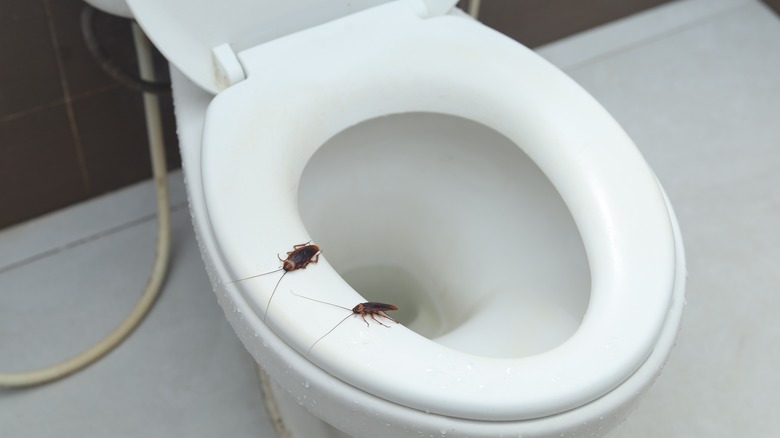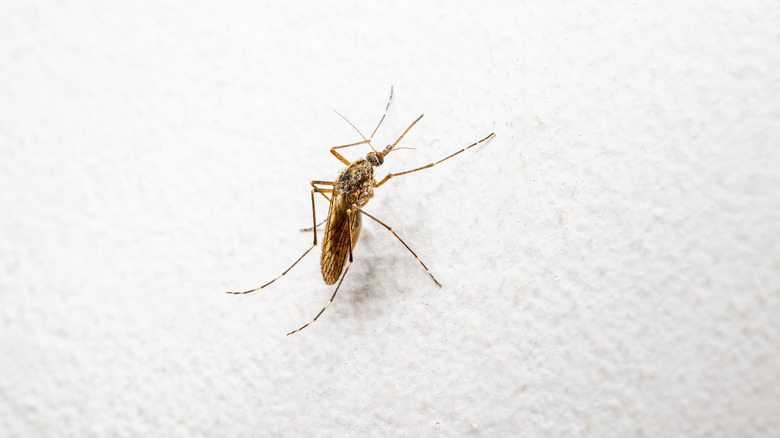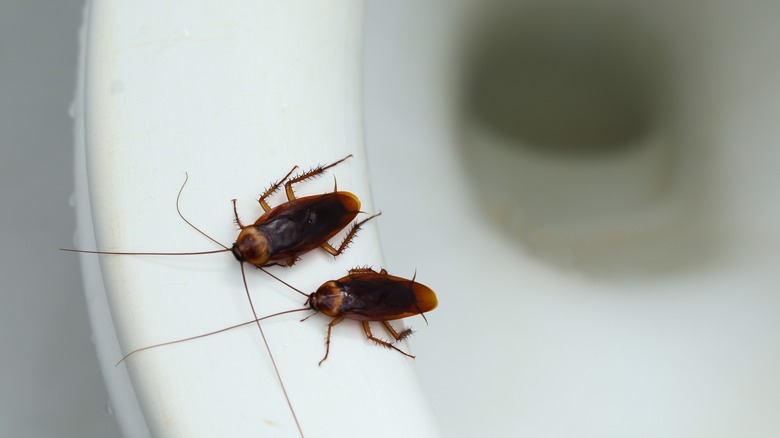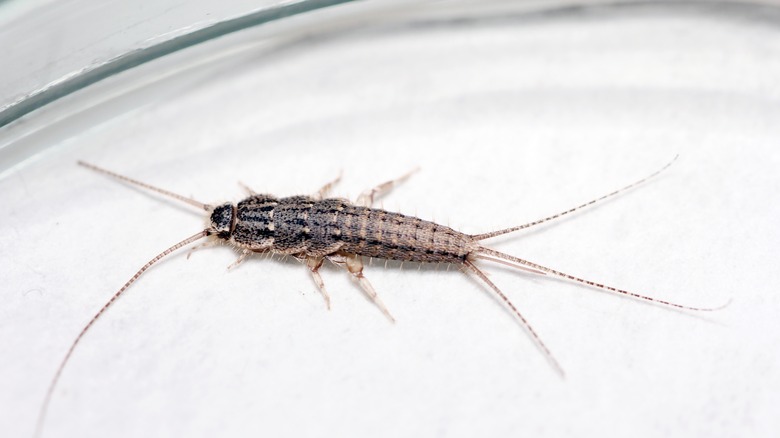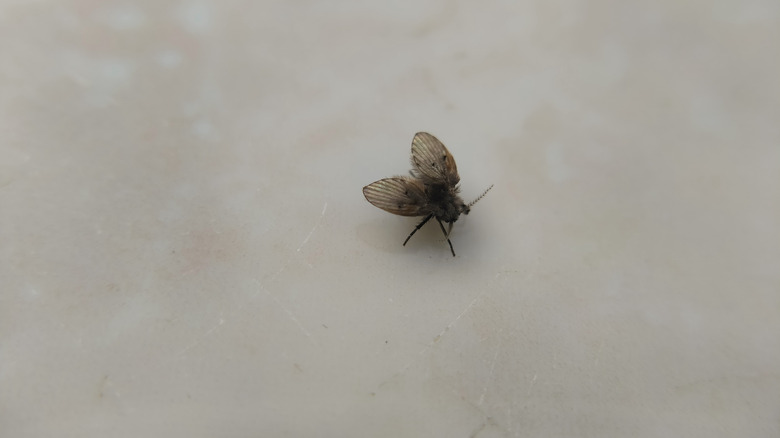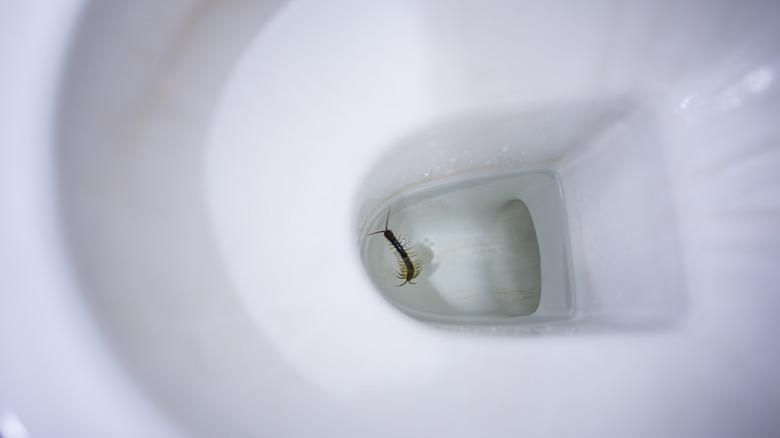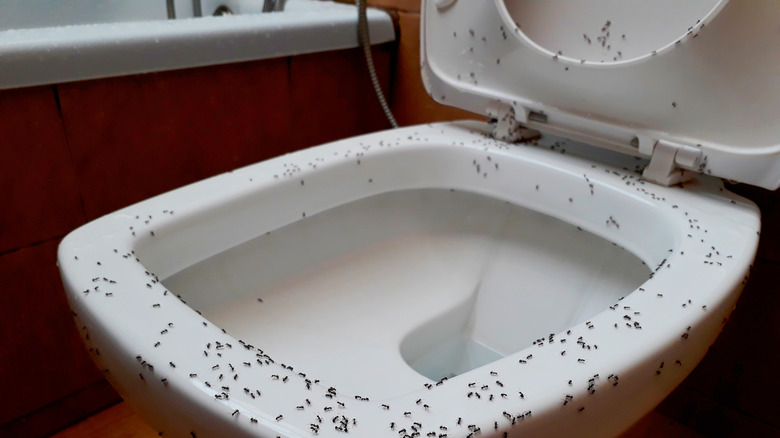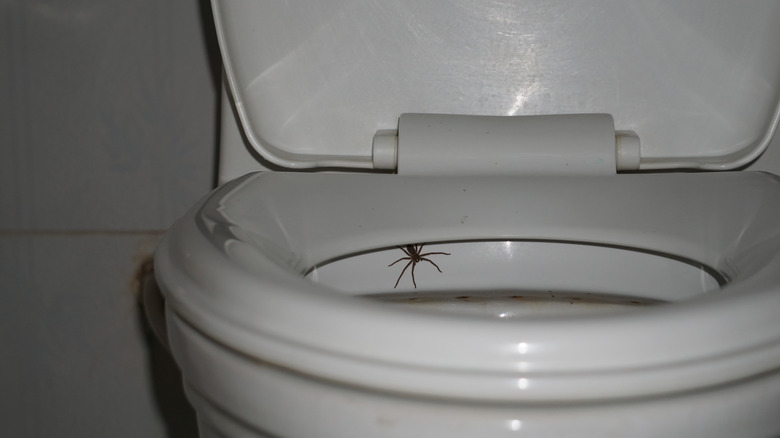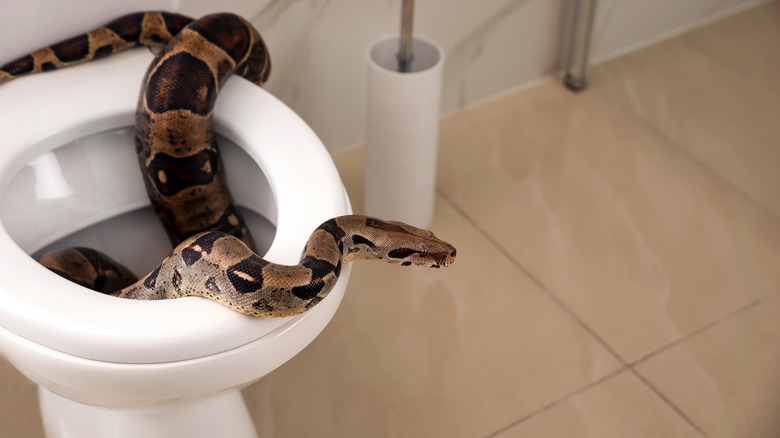Common House Pests That You Might Find Lurking In Your Toilet
The topic of house pests is not a pleasant one, but it's worth discussing. Various insects and rodents like drain flies, mosquitoes, and cockroaches, might be making their way to your toilet from other areas of your home. Your toilet and bathroom — with their moisture, organic matter, and often dim lighting — serve as an unintentional welcome mat. This is about more than just a "yuck" factor. Some of these pests can compromise your health. They might trigger allergies or even transmit diseases. Others can be pretty destructive, chewing through your home's structure or setting up nests in tricky spots. And let's be real: Discovering a pest in your toilet is a jarring experience that can shake your sense of well-being.
So, you may ask, why should you care about this not-so-pleasant subject? Simply put, knowing is half the battle. When you understand what you're up against, you can take active measures to prevent pests from entering your home. Blocking their routes of entry and setting up preventative barriers will help you maintain a home that's both cleaner and safer. So here are some common pests to look out for.
Mosquitoes lay their eggs in unflushed toilets
Ah, mosquitoes. They're the uninvited guests who love to crash your peaceful evenings. You might think of these pests as outdoor annoyances, but they're quite skilled at finding their way into your toilet. They can spot vulnerabilities in your home's defenses, like gaps in your doors, windows, or screens. And what better place for them to hang out than your toilet, where humidity reigns and stagnant water is often available for them to lay their eggs? Believe it or not, mosquitoes can breed in the water found in toilet bowls. They require standing water to lay their eggs, and a toilet bowl, especially one that is not frequently used or flushed, can provide a suitable environment for this.
Since a dry bathroom is much less inviting to mosquitoes looking to lay their eggs, eliminating standing water is the first crucial step. Also, flush your drains frequently and use air conditioners as often as possible. It might also help to install fine-mesh screens on your doors and windows to prevent mosquitoes and other insects from following you indoors. If you find cracks around your doors and windows, a bit of weatherstripping can do wonders to seal those inviting gaps that mosquitoes might see as an entrance. Already have a mosquito issue? Various indoor-friendly repellents are available to help you deal with it. Whether you prefer chemicals or natural alternatives, make sure to read and follow the guidelines on the product to ensure its effectiveness.
Cockroaches sneak through plumbing and sewer lines
Cockroaches — just the name alone can send shivers down your spine. These critters are infamous for sneaking into your toilet, especially if it's not cleaned regularly. You can unwittingly invite them into your home through grocery items, packages, and even second-hand electrical goods from an infested location. Once in, they will head to spots in your home that are damp, so damaged pipes and additional moisture spots near the toilet serve as beacons for them. These insects favor wet conditions, making any nearby pooled water or plumbing malfunctions perfect habitats for them.
You can rid your home of cockroaches by caulking gaps in your bathroom, specifically around the toilet and sink. Keeping your bathroom spotlessly clean also makes a big difference. Regularly clean your bathroom floor, sink, and toilet, making sure to get into all the nooks and crannies. Also, be extra vigilant about what enters your home. Inspect groceries and packages, especially if you suspect they come from places with potential infestations. If you're buying second-hand electrical items, thoroughly clean and inspect them before bringing them indoors. If you find that you're still dealing with these pests after taking preventive measures, it's time to consider more aggressive treatments. Chemical roach baits and traps can be effective, but always follow the guidelines and safety measures listed on the products. Alternatively, natural options like boric acid can provide an effective yet less toxic solution.
Silverfish hitch a ride into your toilet
Silverfish are fast-moving pests you can sometimes encounter in your toilet. These elusive insects expertly break into your house through openings near pipes, narrow gaps in walls, and crevices around window frames. They can also sometimes hitch a ride into your home by hiding in infested paper items. Once inside, they find their way to your bathroom due to the moisture and darkness, which are the main attractions. Don't be surprised to find them crawling in or around your toilet, since they frequently visit all areas of the bathroom. Interestingly, these ubiquitous pests can have a lifespan that extends to as long as 8 years, making effective control crucial.
To get rid of silverfish, you need a two-pronged approach. You can create a repellent made of cedar oil and water and spray it around your pipes (or other areas where you suspect they're entering). You can also go the chemical route with silverfish-specific insecticides, but always read the label carefully. Alternatively, diatomaceous earth is a natural, safe powder that dehydrates these pests, offering a less toxic solution. You'll have to sprinkle it in areas where you suspect silverfish activity. Of course, a well-ventilated bathroom is anathema to silverfish. They dislike dry, well-lit places. So, adding an exhaust fan can lower humidity, making your bathroom far less appealing to these critters.
Drain flies breed in standing water
Drain flies — these tiny, fuzzy-winged nuisances seem to appear out of nowhere. It's not uncommon to find them lurking inside your toilet, especially if it's a second toilet that's rarely used. A weak seal between the toilet and the sewer flange might be the reason they're able to enter your bathroom. Their presence can also be due to a clogged toilet drain and standing water somewhere near your home. They're attracted to the toilet due to the slimy film that naturally forms inside drain pipes, which creates an excellent environment for them to lay their eggs. Before you know it, you've got a whole swarm taking up residence in your home.
To stop them from entering and breeding, the first step is regular cleaning of your drains. Mix 1 cup of vinegar with 1/2 cup of baking soda and salt and pour the concoction down the drain. Let it sit for a full 24 hours, and the following day, chase the cleaner with a kettle of boiling water. That will act like the final eviction notice. This routine not only clears away the organic buildup but also disrupts the life cycle of the flies, making it harder for them to establish a stronghold in your pipes. But don't stop there. Consider covering your drains when they're not in use, especially overnight. Drain screens can act as a physical barrier, making it harder for adult flies to access the breeding ground in the first place.
Centipedes crave damp eenvironments
Perhaps you've stumbled upon a centipede and wondered what this creature with its many legs is doing in your toilet. They find their way into your bathroom through various openings— think holes in your walls, cracks in the foundation, or gaps around doors. House centipedes crave damp environments. They're attracted to your toilet and bathroom since they offer protection and the right environmental conditions for breeding. These areas of the home are like a five-star hotel. With their elongated, flattened bodies and numerous legs — each segment of their body has a pair — these creatures can look intimidating. But they're usually more interested in staying out of your way and feasting on other household pests.
In addition to sealing any holes or cracks in the walls, cleaning is an essential step when dealing with house centipedes. Since they are natural predators that feed on other insects, a pest-free home is less appealing. Some chemical treatments are available to repel or eliminate them, or you can opt for natural alternatives like essential oils. For long-term centipede prevention, create a homemade repellent by combining 6 ounces of water with 25 drops of either peppermint or tea tree oil in a spray bottle. Distribute this mixture on window ledges, door frames, basement entrances, and any minor crevices where centipedes might enter. Enhance the treatment's durability by reapplying the spray every week and after heavy rain.
Ants are seeking sugar in urine
While your toilet might not be the first place you'd expect to see ants, finding them there usually means they're getting something they need. Ants often exploit small structural gaps and cracks, including spaces around plumbing and electrical wiring, as well as openings around windows. In many cases, they're in search of waterand your toilet bowl is the best place to be. Unlikely as it may seem, your toilet also offers them other essential resources — urine. Ants are drawn to the sugar in urine, finding it a rich source of energy and nourishment. That being said, their search for food and water isn't always the reason they end up in your toilet. If you're constantly finding a large number of ants in your tank, especially after flushing, there might be a problem with your water source, highlighting the need for an immediate and thorough inspection of your plumbing system.
If you suspect they are entering from cracks and crevices, over-the-counter ant traps can be effective. A good cleaning routine is also vital. This will help remove anything that ants can use for food or water. Observing ant behavior can also provide vital clues. Ants create scent trails as a form of GPS, leading them back and forth from their nest. If you manage to identify these trails, you can then pinpoint the most effective locations for traps or other treatments.
Spiders lurk under your toilet seat
There are many instances of spiders being found in or around the toilet area, particularly under toilet seats. These little guys are experts at finding the coziest, darkest corners in your bathroom and are quite adept at navigating the tightest spaces to get indoors. Due to the possible presence of insects in such areas, black widow spiders frequently choose to build their webs on the underside of toilet seats, especially if the toilet isn't used frequently, like one in a guest bathroom. This area provides them with a consistent stream of prey, making it a favorable spot for both residing and hunting. So how do they enter the toilet in the first place? Cracks around your doors, windows, or floorboards — these are practically highways for these spiders. Air vents? Just another door for them.
The best way to deter spiders is to seal entry points such as cracks and crevices. Also, consider swapping out bright bathroom lights for sodium vapor lights, which are less attractive to the insects that spiders feed on. You can also surround your toilet area with spider-repelling plants like lavender, mint, and basil, which are aesthetically pleasing and serve as natural spider deterrents. Still finding spiders? It might be time to pull out the big guns. While common house spiders are generally harmless, nobody wants to share their bathroom with them. Opt for spider-specific pesticides that contain active ingredients like permethrin.
Snakes wander in looking fo prey
Snakes in toilet bowls are a startling, yet not uncommon, phenomenon. These slithery creatures often enter your toilet while hunting for prey, like rats. They sometimes enter through gaps and cracks, but they can also navigate through the pipes and, surprisingly enough, end up in the plumbing of homes, including toilets. But it's not always about hunting. Sometimes, especially during hot weather, snakes are just looking for a cool place to chill out. Toilets, with their porcelain bowls and water, offer a nice, cool spot for them. And if you leave your windows or doors open, a snake might just take the opportunity to sneak into your bathroom and find its way into the toilet bowl to escape the heat.
To prevent snakes from entering your toilet, start with some basic home maintenance. Install mesh covers or grates on vents, windows, and drains to block their entry. Keep your bathroom windows and doors closed, especially in areas prone to snake visits. It's also wise to keep your toilet lid down when not in use. For added protection, inspect your sewer system for any potential entry points and ensure that they are securely sealed.
